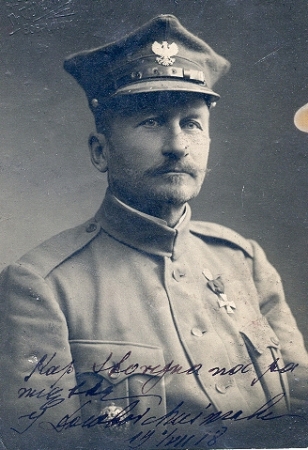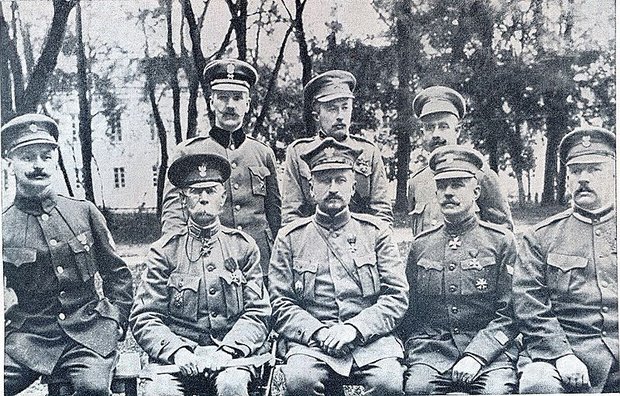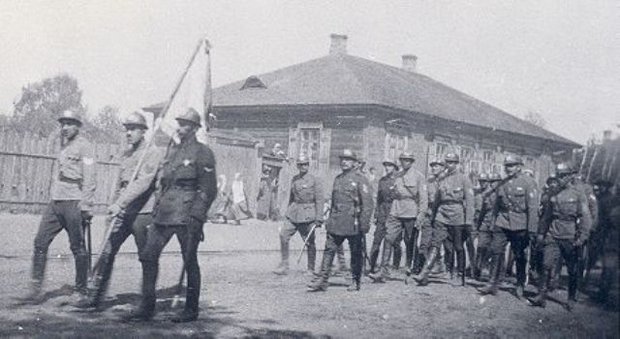
1st Polish Corps
1st Polish Corps
(brief historical note)
In the Russian Empire, 1914, the idea arose of creating a counterbalance to the Austro-Hungarian Polish Legions. As a result, in March 1915, the 1st Polish Legion and two squadrons of the Polish lancers were sent to the Western Front. In September 1916, the Polish Rifle Brigade was formed from Russian army officers and soldiers of Polish origin. In January-February 1917, the Brigade was deployed to the 1st Polish Rifle Division, and the lancer squadrons were combined into the Polish Lancer Division (the Polish Lancer Regiment from May 1917).
The 1st Polish Corps, based on the 1st Polish Infantry Division, was established on July 24, 1917 in the North-Western Province on the initiative of the Polish National Committee. It was staffed by Russian army soldiers of Polish origin, who served at the Northern and Western Fronts. On August 6, 1917, General Kornilov appointed General Joseph Dovbor-Musnitsky to command the Corps. The formation of the Corps took place in haste, and General Dovbor-Musnitsky embraced the challenge. The basis of the new formation was the Polish Rifle Division.

Commander of the 1st Polish Corps, Dovbor-Musnitsky 1867–1937)
A battle with the German army under the village of Pacoslav was their trial by fire. On May 20, 1915, in a bayonet attack, the legion’s servicemen managed to break through the well-fortified German positions. For this battle, the soldiers and officers were awarded high awards: 40 crosses and 40 medals of St. George the Victorious.
Initially, the Corps was intended to be sent to the front. Due to situation at the fronts and inside Russia the tasks of the Corps were changed, so it was not sent to the front. General Dovbor-Musnitsky decided to retain combat-ready Polish units in the rear with the aim of using them as the core of the army, re-creating the Polish state within the borders of 1772, taking a position of non-intervention in the internal Russian conflict. The presence of Polish armed forces on the territory of the RSFSR, not controlled by the central Russian authorities, led to clashes between the Poles and the Red Guard. In these battles, in early February 1918, the Corps won several victories; the most important was the occupation of the fortress of Bobruisk on January 29, 1918, besieged by a 7,000-strong Bolshevik detachment. On May 21, 1918, the Corps was disarmed by the Germans in Bobruisk Fortress, after recognizing the sovereignty of the Regency Council and the Germans' request for the surrender of the Corps.

Headquarters of the 1st Polish Corps, 1918
After the signing of the Treaty of Brest0Litovsk, the German authorities decided to disband the Polish Corps, which was allied to the Reichswehr. After disarmament, the soldiers of the Corps went to Warsaw, where they played an important role in the conquest of independence, and later became part of the Polish Army.
In the fall of 1918, the soldiers under the command of General Dovbor-Musnitsky took part in the formation of the Polish Army, becoming the personnel of several regiments. The soldiers who remained in Russia took part in the formation of the 2nd Polish Corps.
In Bobruisk, on the site of a military cemetery, there was a large mound, under which about 2 thousand Polish soldiers of the First Corps were buried. Now there is not a trace of this mound. A smaller copy is located at the Powazki Military Cemetery in Warsaw, where in the interwar 20 years they buried soldiers of the 1st Polish Corps.


